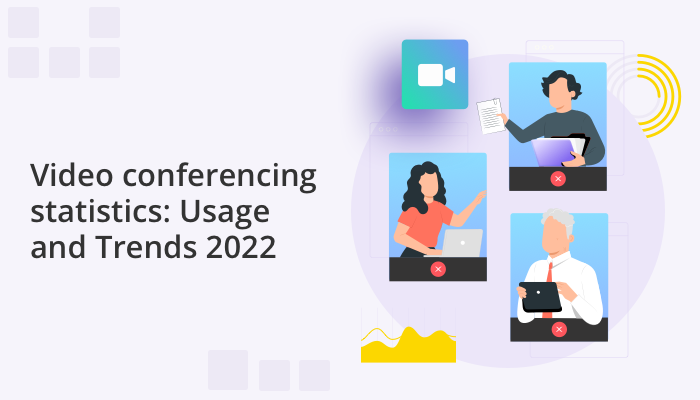
With the rapid rise of remote work and online interactions, video conference meetings have grown at a staggering rate. Since the onset and spread of the COVID-19 pandemic, an ever-growing number of individuals have started working from home and as they have, increasingly adopted new forms of digital communication including video calls.
Businesses have shifted to video conferencing not just for internal communications but also for client meetings and customer interactions. Video conferencing tools have come to be workplace essentials, whether the nature of work is office-based, remote, or hybrid.
Video conferencing statistics 2022 show that the trend continues. When we take a look at the numbers, it becomes obvious there has been a surge in the use of such tools over the last couple of years and that their usage will grow in the future.
Read on to learn more.
Increased Use of Video Conferencing
The sharp rise in remote work is reflected in video conferencing statistics for 2021, which revealed that 55% of companies permitted their employees to work remotely, and 30% of employees were working remotely full-time. The rise in remote work led to an increase of screen time, by one estimate up to 40% of an individual’s waking hours. In addition, Zoom’s revenue increased to an astounding $1.021 billion in just the second quarter of 2021.
Moving to video conferencing statistics 2022:
- It is projected that 82% of all global IP traffic will be video by the end of 2022.
- 73% of employees say that there is increased interdepartmental and inter-team collaboration due to the increased use of video conferencing.
- 72% of companies report a greater amount of client collaboration via video conferencing.
What’s more, video conferencing is not just limited to remote and virtual work. It is also being used in the physical workplace. Huddle rooms are projected to replace almost 70% of the meeting rooms by the end of 2022. A huddle room is a smaller audio and video-equipped room companies use for quick team meetings.
Top Four Benefits of Video Conferencing
So, why is video conferencing such a must-have tool? There are tangible benefits to this form of communication, which means that it will continue to be popular in the workplace, long after the pandemic has gone.
1. Reduces Costs
Video conferencing reduces travel and staff expenses for businesses. This has been a major cost-cutter for companies.
- Virtual meetings by video reduces travel costs by 30%.
- Organizations can save 75% more when they use cloud-based video services
- Improving employee efficiency via video calls, and removing the costs associated with holding in-hold conferences can save an average of $11,000 per employee.
- Its cost-efficiency is encouraging business owners to invest in this technology. In a survey of CFOs, 56% plan to adopt video conferencing technology to reduce travel expenses.
2. Enhances Productivity
One of the key benefits of video conferencing is that it enhances efficiency and productivity in the workplace. Multiple meeting can happen in one day, regardless of where the participants are located. This is something not always possible when attendees need to travel for in-person meetings. Also large-scale conferences with multiple participants are much easier to organize.
- 94% of companies state that productivity is the main benefit of video conferencing solutions.
- Video conferencing enables easy collaboration across departments facilitating work processes. Almost 9 in 10 employees say that video conferences helps to expedites work tasks.
- 79% of workers believe that video conferencing is as effective as physical meetings.
3. Improves Employee Engagement and Satisfaction
Video communication enables employees to build better connections with their work colleagues while they work remotely from home. Better connections, means contented employees who participate more.
- 55% of businesses using video conferencing found that it helped their employees engage better.
Remote work has become the norm for so many people, who appreciate this model of working because it allows them greater flexibility and an easier time managing family commitments. Hence they are pleased for any tools that support them to work effectively from home.
- Roughly 80% of employees claim that remote work, supported by video conferencing tools, has bolstered their satisfaction at work.
4. Bolsters Customer Experience
Surveys show that customers also appreciate this form of visual communication. Empathy, understanding, and interest can all be communicated through eye contact and facial expression, leaving customers feeling that they have been seen and heard. Visual communication with screen sharing is also a convenient tool to explain products or services. Customer feel information can be shared and understood more clearly.
- 51% see companies that use video conferencing solutions as more innovative.
- 90% of respondents felt that communicating through video helps them get their points across better.
How Is Video Conferencing Used?
Whether it’s one-on-one interviews, or multi-party meetings, video conferencing statistics show that it is being used for various purposes. Some of the major uses of video conferencing are explained below.
Connecting remote teams and facilitating internal communications
Video conference usage statistics show that it can help companies and employees have smoother internal communications while they work remotely.
- According to video conferencing use statistics, 80% of video conferencing is used for one-on-one meetings, and 78% for team meet-ups, and 77% for large team meetings.
- About 96% of employees surveyed said that video conferencing increases the connectivity between their remote teams.
- As per video conferencing usage statistics 2021, it enables better collaboration and communication for 99% of people. In the same study, 89% of people found that video calls helped them feel better connected with their colleagues and the company.
Direct communications with clients and customers
As more companies use it for B2C communications, the future of video conferencing seems to be that it will play an important role in a company’s client interactions. Video conferencing technology trends show that the use of web conferencing technology for client interactions will grow. Clients will be able to contact a business through direct video calls.
- In fact, 80% of employees currently use video conferencing tools for one-on-one calls.
HR and recruitment
We’re also seeing video conferencing tools making significant inroads into HR and recruitment, with many HR departments relying on this tool to conduct interviews.
- 86% of companies now conduct interviews online to find new employees.
- 66% of candidates prefer to use video conferencing as part of the recruitment process.
Marketing
Video conferencing tools including webinars have have been increasingly used for marketing purposes, demonstrating products and educating potential customers about services.
- In one survey, 95% of respondents claimed that webinars were the key to their lead generation and marketing efforts.
Future Trends for Video Conferencing
Video conferencing industry trends seem to show a rapid development of the market and use. The video conference market is also boosted because of the pace and way in which consumers are adopting software and cloud video conferencing technology, especially small businesses.
Consider the following statistics:
- The global video conferencing market share is expected to grow at a CAGR of 15.45% during the forecast period 2021–2030.
- The global video conferencing market was worth $14.6 billion in 2021. It is expected to double to 27.3 billion U.S by 2026.
- In the US alone, the market was worth $5.5 billion in 2021, and is expected to rise up to 9.7 billion U.S. dollars by 2026.
At the same time, stats show that remote work will continues to rise, ensuring the right conditions for video conferencing to remain a valuable tool that business owners will want to invest in.
- According to a survey conducted by Upwork, 22% of Americans (roughly 36.2 million workers) will be working remotely by the year 2025. This is an 87% increase from pre-pandemic levels.
To Wrap Up
Video conferencing trends show that the surge of this technology over the last couple of years is not going to take a downturn. What began as a way of coping with the pandemic has become a new work culture.
Video conferencing tools are thus set to form an integral part of work interactions, whether it is with clients or internal collaboration.
If you’re interested in building your own video conferencing solution for your company, speak to us at Quickblox. Our software consultants would be happy to discuss your business needs.







I appreciate you sharing this blog post. Thanks Again. Cool.
There is definately a lot to find out about this subject. I like all the points you made
Thanks. This had some useful information.
Hey there! Τhis is my first visit to yoᥙr blog!
Ԝe are ɑ team օf volunteers and starting a new project in the same niche. Your blog рrovided uѕ սseful informаtion to work on. Thanks !
Great to hear that. Good luck with your project!